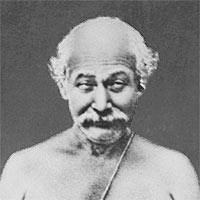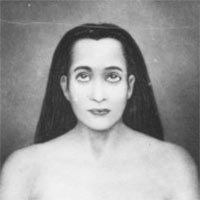Sri Yukteswar : A Guide for The Journey
- Kübra Karataş Ivanova
- Feb 22, 2024
- 5 min read
Updated: Feb 14

“Every day with him was a new experience of joy, peace and wisdom... Sri Yukteswar was a dignified person with a down-to-earth attitude. There was no trace of confusion or wild imagination in him. His feet were firmly on the ground but his head was in the sky. He respected practical people. 'Sainthood does not mean stupidity! Divine realizations need not numb and incapacitate man. It is through the active expression of virtue that one can attain the sharpest intelligence.”
Paramahansa Yogananda
“His commitment to his principles, boundless compassion and deep understanding were rooted in his direct perception of reality rather than in his intellectual work.”
Swami Sri Yukteswar / Holy Science
An Indian Monk, Yogi
He is a Kriya yogi, a Jyotisha (Vedic Astrologer), a scholar of the Bhagavad Gita and Upanishads, an educator, writer and astronomer, guru of Paramahansa Yogananda and Swami Satyananda Giri.
The Beginning of The Journey
Sri Yukteswar was born on May 10, 1855 in Serampore, India. He was given the name 'Priya Nath Karar' at birth.
After losing her father at a young age, Priya Nath took on the responsibility of managing her family's land holdings. An intelligent student, she successfully passed the entrance examination to the Christian Missionary College, Srirampur, where she developed an interest in the Bible. This interest later manifested itself in his book “Sacred Science”, which discussed the unity behind the scientific principles underlying the Hindu Scriptures and the Bible. He also studied at Calcutta Medical College for almost two years.
After completing his studies, Sri Yukteswar got married and had a daughter. However, after some time, he bid farewell to his wife to the other world.
Lahiri Mahayasa and Mahavatar Babaji
Sri Yukteswar's search for Truth led him to the great sage Lahiri Mahayasa, who praised the sacred science of Kriya Yoga as the most effective method of attaining God realization and was the first person to openly teach this ancient science in modern times. Through Lahiri Mahasaya's guidance and his own kriya yoga practices, he achieved spiritual enlightenment.
In 1884 Sri Yukteswar met his guru and in the following years spent much time in his guru's company, often visiting Lahiri Mahasaya in Benares.
In 1894, Sri Yukteswar met Mahavatar Babaji, the guru of Lahiri Mahasaya. One day Babaji told Sri Yukteswar that he would send a student to share the teachings of yoga in the West. This student was Paramhansa Yogananda, known for his book Autobiography of a Yogi. Babaji also asked Sri Yukteswar to write a book about the fundamental unity of the Bible and the Bhagavad Gita, the most recognized sacred text in India. Sri Yukteswar called this book “Sacred Science”.
Ashram
Sri Yukteswar converted the large two-storey family house in Serampore into an ashram called “Priyadham” where he resided with his disciples and followers. He also established another ashram in the coastal town of Puri in 1903, which he named “Karar Ashram”. Sri Yukteswar taught students in these two ashrams and started an organization called “Sadhu Sabha”.

Teachings
His interest in education resulted in Sri Yukteswar developing a syllabus for schools on physics, physiology, geography, astronomy and astrology. He also wrote a book called “The First Book” on basic English and Hindi learning for Bengalis. He wrote another book on basic astrology. He then became interested in the education of women, which was unusual in Bengal at the time.
Yukteswar was particularly skilled in Jyotiṣa (Indian astrology) and prescribed various astrological gemstones and bangles to his students. He also studied astronomy and science, as evidenced by the formulation of the Yuga theory in the Sacred Science.
In 19th century Serampore society, he was a progressive-minded figure; he regularly organized religious festivals in towns and ashrams throughout the year, created a “Satsanga Sabha” spiritual study organization. He created syllabi for educational institutions and reanalyzed the Vedic astrological yugas.
Known for his sharp intellect and insightful knowledge, Sri Yukteswar became a revered guru of Kriya Yoga students in the greater Calcutta area, and also regularly invited individuals from all social circles to his ashrams to discuss and exchange ideas on various topics.
Sri Yukteswar and Paramahansa Yogananda

Sri Yukteswar had only a few long-term disciples, but in 1910 the young Mukunda Lal Ghosh (Paramahansa Yogananda) became Sri Yukteswar's best-known disciple.
In 1920, Sri Yukteswar sent his most important disciple, Paramahansa Yogananda, to America to spread the knowledge of the science of Kriya Yoga, which liberated seekers of truth all over the world. To this end, Yogananda spread the teachings of Kriya Yoga throughout the world through his all-religious organization, the Self Realization Fellowship, headquartered in Los Angeles.
As a guru, Sri Yukteswar was known for his sincere insight, stern nature and strictly disciplined training methods, as his disciple Yogananda noted in his autobiography. The rigorous nature of his training eventually prepared disciples like Satyananda and Yogananda for their intense social work in India and America respectively.
In keeping with his high ideals and 'penetrating insight', Sri Yukteswar was seen by Yogananda as a “Jnanavatar” or “Incarnation of Wisdom”.
Yogananda attributed Sri Yukteswar's small number of disciples to his rigid training methods, which he said “cannot be described as anything other than rigid”.
Regarding the role of the Guru, Sri Yukteswar said:
“Look, there is no point in blindly believing that you will be saved after he touches you or that a car is waiting for you in the sky. Through the guru's guidance, the sanctifying touch helps wisdom to blossom. Respecting this sacred gift, you should become a sage yourself and follow the sadhana techniques given by the guru to advance your soul.”
Sri Yukteswar left his body on March 9, 1936. Shortly afterward he appeared to Yogananda and explained to him the nature of the afterlife. This account can be found in Autobiography of a Yogi.

“Sri Yukteswar's intuition penetrated deeply; he usually responded to one's unspoken thoughts, regardless of the reaction they might receive. If his speech had not been so blunt, he would have been the most sought after guru in India.”
Paramahansa Yogananda
“Sri Yukteswar saw no insurmountable obstacle to the union of the human and the divine. I have come to realize that there is no such obstacle except the lack of spiritual adventurousness in man.”
Paramahansa Yogananda
“He was fully equipped to recognize the underlying unity between the scriptures of Christianity and Sanatan Dharma. He was able to lay the sacred texts on the spotless table of his mind, to scrutinize them with the scalpel of intuitive reasoning, and to separate the additions and misinterpretations of scholars from the truths originally revealed by the prophets.”
Paramahansa Yogananda

“Sri Yukteswar had a gentle countenance and voice, his presence exuded a pleasant air, and he certainly deserved the deep respect that his followers felt for him without a second thought. He was held in high esteem by all who knew him, whether from his own community or from outside. I vividly remember him, tall, erect and ascetic-looking, dressed in the saffron-colored dress of those who renounce worldly pleasures, coming to the entrance of the hermitage to welcome me.”
W.Y. Evans-Wentz, Writer of The Tibetan Book of the Dead
Sources :
Holy Science, Jnanavatar Swami Sri Yukteswar

